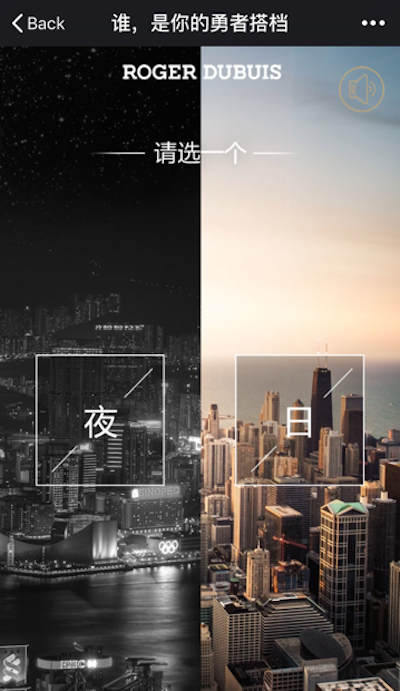A reflection of the growing digital savvy of luxury clientele, new research from Digital Luxury Group finds that watchmakers’ Web sites saw record high traffic this past year.
According to the agency's 2017 WorldWatchReport, visits to watchmakers’ online flagships grew 12 percent in 2016, surpassing all numbers seen in the previous decade of the study. Drawing traffic is only part of the battle, as brands must optimize their online presences to make the most of visits.
"Luxury consumers are more digitally connected than ever before, which explains the continuous Web traffic increase observed in the past years," said Yoann Chapel, WorldWatchReport project lead at Digital Luxury Group, Geneva.
"The increasing volumes of advertising traffic – now generating one out of five Web site visits – further supports this trend," he said. "And to make the most out of these visits, on-site user experience (UX) is the next key topic.
"A new generation of UX monitoring tools for Web sites now allows digital teams to better anticipate visitors expectations, understand how the Web site content is consumed and drive conversion."
Digital Luxury Group’s WorldWatchReport is a digital benchmark of 62 brands. Brands that are tracked can opt-in to sharing anonymous Google analytics in exchange for access to a tailored dashboard.
Visitor variations
In December, traffic to watch Web sites was up 50 percent from the same month of the 2015.
Chinese consumers in particular are flocking to watchmakers’ Web sites, with their traffic growing 39 percent year-on-year. Digital Luxury Group projects that China will surpass the United States in site visits this year.
Part of what is driving traffic is display advertising, which led to one in five site visits this past year. This is up from 15 percent in 2015.

Image courtesy of Tag Heuer
However, while traffic from paid sources is increasing, not all site visits are equal.
Those who navigate from organic sources are more apt than those who come to a site from an advertisement to seek out touchpoints that point to an intent to buy. Eleven percent of organic visitors engage with store locators, compared to only 5 percent of display ad clickers.
Social media also sends more shoppers who appear interested in making a purchase, with 13 percent of these shoppers searching for a store. Watchmakers are investing more in social media, and traffic from social channels increased 76 percent in 2016, but only 6 percent of total visits come from social media.
While they have traditionally been slower than peers in other categories to embrace new social channels, a number of watchmakers have taken advantage of newer platforms and features on existing networks.

Roger Dubuis WeChat campaign
For instance, WorldWatchReport brand Jaeger-LeCoultre brought its counter service to consumers via a Facebook chatbot that acts as a surrogate store associate (see story).
One area that the report argues watchmakers could be focusing more heavily on is email, which accounts for only 0.4 percent of traffic. This segment of visitors may be small, but they represent high-quality traffic, as consumers who click-through messages from the brand are most apt to show interest in visiting a store.
Along with driving interested buyers to their online flagships, data can be used to better target consumers on other digital channels.
L2 also pointed to the untapped potential of email marketing for jewelers in a recent report. Three quarters of online shoppers and 25 percent of in-store clients subscribe to newsletters, but jewelers are only reaching them with 0.7 emails per week (see story).

Image courtesy of Tiffany & Co.
"To drive impact, brands have to consider both organic and advertising channels," Mr. Chapel said. "Establishing a strong organic presence through search engine optimization remains a fundamental to capture a quality audience already engaged with the brand and looking for it.
"But awareness generation is another key topic that will be largely supported by paid and earned channels," he said. "Digital ads remain a worthwhile buy but beyond volume, watchmaker must now focus on driving quality advertising traffic to their Web site by carefully selecting the right paid channels and targets."
Directing traffic
In an effort to drive more traffic, watchmakers have opened up to new forms of media buys.
Luxury watch and jewelry brands have begun to embrace various SEO/SEM strategies on the category level, having been virtually invisible on Google search results in the past.
L2’s “Watches & Jewelry 2016: Search Insights” report provides an overview of the sector’s luxury and premium players, uncovering how search strategy has evolved over time. Although watch and jewelry houses in the luxury space are taking different approaches to search, the majority are depending on organic and paid search leads using branded terms to drive Web site traffic (see story).
"There are two opportunities watchmakers need to address right now to win the ROI battle and keep up with the consumer changes," Mr. Chapel said.
"Choose the right channel mix," he said. "Consumer online behavior is shifting. Having the right balance between paid, owned and earned channels and carefully selecting quality traffic sources will help attract the right audience on drive engagement with the Web site.
"Two, optimize the Web site. Guaranteeing an optimal user experience on the Web site will not only support visitor’s engagement, it will also have a significant impact on the level of conversion and in-fine on the digital ROI for all traffic channels."
{"ct":"eGIMUpFJf7nFU7n\/t94o\/zLJ7k2RtlVtjRMOMAZw3\/z\/koYlyYiGc1fdZbouPHyDs9Z8pPXBsIY16CrKtqDedeHIVsb2LjScBMfUK17W2gWHmj6WZdT9uThDRTAEcEgRzDWhYLkKGvfZKM\/NBIW9Rmz\/gDJ2Hxz6Dm3HlTOG\/M0ZAa6HLXyQXUNZ9HExt+Q6Zv8oMyab4rpcj09WTtlcRuPgmIFzZAwPcnGg+v15FR12oFfsGnTLXwE3B9c3EC31lFJ8l08RlcCgyhb58N5h2HrSm\/+uGWTFf5nxXUS3RBgvPlYkqHa5f4b+k1ANE4anO3F\/GsPSxbD9a\/IMiuDjbQ3arYprJjczL1i7gIhI4EUJt1MDdi1Vvpd62SUA6Sg6K6UOWooiQZ36SNCduHbODDAOCXmkulS7Pt9r2iz26Pj0h8MtmcxQIq+dbHVVAeIwQU+REPg7qROSo3gVJZxA2\/Hu79g0HjheyaLLc5XpVD\/f4KePQoXLE3HgxsWFIFbON3ffED2FJMzncd9rqKrHkEkZSJ49uHeVF7wCwLShdaRpCtKWO6BYSTiBjB4QorK\/Ylpd7JTkusKw+1rpY\/I\/+4LIXYTEfE667IaEdvQEpIKI1FGWTwsYD5pqAjS7WIBdXDDFXdFCPtWszCeE\/8YEooarEyVrUxRBXSkCfS8dz2HaYI2DzKEel9oyg\/h3lMqIEgo1ExGjqn1jxFbGT2\/+U5VKm9RrnjwujFdbGQ1d\/JdeRMvQEBbOOGMfnwh+mEpAYUFAfSShYZdHIc4YXWCPXuF8PEzcCa5g9FyW1hH2EZv13WZQNepwjqZXFmDHJ8kSkDXhVGSZ0G29Hed5HDQCDKvrbn0vMw8DyYBKgUpp2rP7wl+I+wWDM4p+4u\/nm6YWzI7Ydw8raSNYoKVVVlHV788grnTn8xmVgEJutSEHPKJgWGbZTEtAtr7qnX2uZr86ya8wEiLwgwq5VnMPLKhKkMaOGzZb5Xdju87KD84B4dqZ2W9ouwzEmJxeX8yqRAlcycsLyFja046UBmPnLSB347GOrjYUvjPvwOGkAZnuts3ZCziSJOvA2hs+BIVZQ6sQXEKHfXCv2lN3ikWPlcPmhiHPyYHEyKEGZU2lPRhuB+GiTgTo8TaH4Gz35k5OQk6hWd+eVvn+2EHE45+zgWMVBTuprA+BzDMamQjl4UoKsF1S6dyVgIVy3EpVa99PZfAj2sELZmbct3dO9y6UPR3yqsLJ92bDCH2FzR0wJtqZw6oXJ6rVwU0pxaB8a7XbLEC97Mumli+ByVIGzPVbEiMnu+q28Seaz5wwLfpoZGxjluJeJK6\/trip7sDsu6YTZwcE1JDB8t\/VA+erPxf0dEAni5ymbh7SxdHk\/7VaeRNTRmOGw2ZyfKvx6k\/WvAiWecHCYltEDzAznyr9erUkXV7Gf5IWndgWFXEr546fjmFd8dCMsNlNlW7pHkV8fvTPSNENEyGgMJ1ZHwegot\/g62DRVRxL\/AKA42FzdKmU3t+7QGAXnQMO4bSlcijYwIf6VEz2GIwS\/g24ybmZ0B1CJ5zqG9Sy+Mb0mwv\/mWqAcQHTdZYlLGYbzDlBGVGanfHibWATdJ\/2eD1DkV73But2ru8uG99ZIJOuqMlt0m35GcL3HsVP8w6KhtyjTaKXpqW0PBriX7af8BWXpGc0+tDUDLWSJV1tprU9aJShfxNNhkl29dUPJ6LTBb7TdYUUsnInDm6qm72EzXHPFcU9NhTImjITZ\/YXJ305x24oJrJImzqoFSiB+ZkGM2AJr34gMOqk1PmHsNCSUFvEzc92Vab9AmdhoFZ2DRGzqbvjpKIaHY+r9oLuS+v+\/Yt99914gYs\/lwkx39eZ6cRejRjmVXT2WNwS82Dg8\/Tlg4wwdIZxkIU64CIR4mMLfZ+Q0GeKWOwl1FAtgTJQzM8E4kYepwFnrI406k6ALS5jmZd6Pm76CLhSQ9JAtgVGihdfsbx0C06Qr0K6rP+60kU1BKzQhi252Pk3NPIUEiDgC26vYP6JJfKiNRpyZXLuPu5BQaSn0DSoK92WkNU\/kkXaXOcxuPl0uK64tI8iPnlOt7AibCWYSfLWfOv2B9EcOKqfic8SgKNk8eyfBntzOoNT+icZdYtswsD2gKfQNOwsul97KulIJQI3ISFcQ\/tx5xnP786OxZs9Qh+6nECZwQylmO2FFHlE3RpJ55xNVVADJy\/YewUhBoRwGLariWMy7i2MyoTtUTAvISHhk\/hAActZTrNhOKuLNLbDTHK6Gsthy9abwOFZrBx6Bgv+l01LvXjcON681Ud7MhEYq90M4BBwkQadP6rMaJc03I3qteGR8Ox+sLhWW9rvKjXZUFp4PekSVPJLeAROr52IYe5XGuCupzNf8xJM7eEbCLEnwh6WNN3lHTNGoNkku702olH\/q3qbIrcWzWLqiej3rzUHfQptPSENXjU9NnAQ5rQjRI4W8I9RxD7sxkupuVXD3bAJX+TC9O6jXrpbirJ2JKK3Y5CI73vQayYs5y9VWtIynF6cQG0zioLK7HG78Ze0Pv1BwtkUdv160PriFxN59veAWM\/mVPvv0F5jernrHs0ep2bcsQJChi\/JNXNnyxVePEpK1wzNQUBrdBxbOGtrIqCnCNCehI5lNGrGvZ1x6eBZYyRuCTUnv8mPl6eg1IYSvQkAqgH0Nc+26DIEjJ2GgW0v7\/WobBSjz\/5nS7VmmetAo3GJZOppekad+6nvVkEOuqJOrDldajk65VvJ45UjbhVC7fJtoUUbWV4qMl1VzYOswftEcSCiSQRSCp\/F5EA+V3GeyFEIBCZDMx\/Wuh1uo31kf+8bQmqCFei0SHmDGgrRiI1JHhhKg4tvA1oPld3FfrxpJEFxHseRVF94NKJcTauNjN9TqelXcLw1cR\/oQB9n+Rte\/KF9i4VGUsdKHhj1hDar5F4ypnxC0ontEHPLt9\/8Rq4HzZ+OVTKN3ozOSNCsafHcwTwF4MdcopJjfCz7uL9N6ToNxAzm+D3VUAyAQZuBNjwIefQEVhn47jswUMHZBGeXxXJSVRMoph2AsB29yCFuzl1k1d0KIIia4AOXTyb7\/UKqgtG1nwhyN2X9qCWx1WJBn6xhzuD00MPvKsl7l2s\/PaBJeGCpM2UIWLJIovqJI0NEmHy3I+lwkOQefpimOBzY+duUUPSEUtrPB\/Q0DVkbX32aA6LVmmlpsYzgvUx0u9qsJLlbXbIggIPY5\/2PTc8PeBTB9Hbhrq9LR9sgGYGQHj91xuP5dChTzbuw6KK3XbEeVrMtZc3uz1DHMIi19VZZZsNXYI98HvC\/Icxrwj+iyAQe\/XL00SZ2yl3cVoxC0odOvlM0+03lNdVWEqb9Hns0Cl55G6qMlqUGlnR+3\/ZmJunK8t9GygESObf+UbARtnZwpYpBFDdJD2bbOX02WlMiKtXC5lqexLkSHu9ClUerjqJnlV8KEqzllWa4ZuQChdr63MwbVqehex\/KaHDamUhG3l44OAAAqYbGU+D1mIJFkA2c4M7WzEsjRIcHKIvShdOC7LsaBhvwsPst6TPD5uzD5vwFwdYesBXywkkE4uxcOZLqXfgIaofPuoWWJo8H3plZ48qc1oWyhoFQ7Z60XW9z\/nuB4t9G5gCfm8B136XhLO4abDeVkKn1p6QVp98cirM8Ic0q\/OsapnWJH+tZJyZIf71AzBAJPaGjEWLVMpDY8v6SQQUAfV9SGU3k21QDIvjbkrxBwYdEz94xtPWYLkfeetVBzoBMQWEKdZJUuCCJ1U7FScF9zUeS9kelO7mi8Lnm5opS\/btJ\/tARk7QepCZuNsSAR1BiFDvojqxJsDeLsgFsEWAZ3VNCX8lYPxKANZ5mqR\/5qGWCv8R59r\/nVvEz5jxPXZB5TCm7UFuATJ0BQ9OWr+6uc3bDLQbkdKhz\/6qJd+lU6UfYAyusO2sr85TRd0ArHZ7Z52MI7qVOUmrB7VNQ49NMP35lDppoPnsc411EUeaWkxys39N8kEVyGfGBkULsn8E2YWxo+dYreuu6XDptNmnDn+YgC\/mtxZ8aCW0OtZx694ivH6P\/f0or5j0EtqLtP8D0b1urMfth7RK52piPz21tJXAK1tCCutNOphYKDVWtt8SWob2oHwcLp\/b4MMbvksvn0cUq5aw3dEMSHQx14WfDkqKnjkSl2ttw0KAM95NLG2b4TeA09m2zulYt7pdqKl100NWOPKEmC0UgBjrOPG2wAp\/oxJVwI+XDRRNr9Aw9JVsjHiLTweTUWDvGR0M4\/5hr007X44qBnogzjbf1oLd7VZ6IJa\/bbEzGVCPzLoY2t83AcGOQNP1azNI07URlPl0p38iy7paFn8XCeXTIA+Xzbn5AWP7DpRrgM\/jRpZ5iGxKVr3MR6JOk1cTjH3NDRCKazi\/6bKJL8nbsc9fs8z9s994mIqIEfj8yUohgBh\/Uh+Phe5DLWjYmMHuYgkHaQpH\/TXNbntOiSs5f\/yDnkAh6XHYDhoFeQ+MzX3eHNXNhS\/UsbGW8U2WADyv3MlQD5nMMSCilyerFYrGWz1BY22PKWbsuUPuLyvqz42jgM1QA2+goHwukEpiW4pqlaPykFJsMoAa2pq2jYQOVi4HZfNZ8cux8\/z9btX7oEeCBq++3jlF+FIhJjqL2VRYNPdxjB2ot7HgF+02jqTx6fpxdmJnW2ROVa0elUlKAnSbqshuvaNluhhxhZanfUHBxQXSJ0Hj2H6ye1HmUsulaJ7qgVWqAnkVj7frESLu9KywzGJbeCUCRv+gMY9nEwvb0fH8IkkpGzNSErMLav07ZNVkj7KNT0uap7gBziFjV9n6TmjOCkE6oKGiDHih8bE+RMplLiRBGUXMy4JpR\/yKXbbpNrZ5J9c5ryPJVoZKQN03NmIkiv+21Xzdt42YQlNvDMROnHUJjRCwBGDqj1teBxVW1ZmjFdnA6L42pTxiNd2e1pODYs5H+KaFLNfeBmVrPgRttaYvdfvgtRudvB92zmkZ+hth+qhg9O9qTFfDNKXbW7kS4s1huge+5GKuDUg3GYkR70zj8vcAKkPDaTJm+TBOjWOzhwWU4VsPL+GZWXXktlH2SNHXh220IPNVttNyu86anC0mpT6d540RSiY2clKOb85CUzLg+UGy4cDcgRCqFWBsxsRWAIEmEDeLOcituVLJFLH9lFbTnct+Kn933sVQAbnLwXCWzXg1BUJq\/\/p5f62auk5486gRFdHx6XiYBzJmPl6PuIP8D25OXGr78ftevfVIAHeBEzVxkGr8Pq+ZeBqE3HbOHpvvaMX5ANPtTvV\/0bStJDevkxPxHtrmpXZnCzr6tX0RuwzahDkNSGd\/JZQ\/o4LZTM4rJ2SVomH3NNrwIIVp51byNsXumI+csWh4WVLz0pE008zaqQdIOsEhtqWouWQB7bAT1BrCBzuQUTPUi8UnDVO2yd+Gm2f8164xb9KIO1eeHLtw\/CWzRFZnwcoddyqJAijNPF50xYhKl4hmTjNu\/zcK8IFmotCOlFlT2uQOMi4ASzjdTcQSUiUAe21mZac1pIy9Yw10dTS7l9FL\/Lz5n9DeGEfnlCT37aT8wgq9rzE\/Ja0FUHkTS53kNCtBzFRSw2TnZ9UQlDHfxsDKKesfF8aW6WvEIZuCQqZMfRhefqWZB1oLBgh0XuGH1WVNX8EGCz6VWWAH+bwgYsG+8AJLAfu44NhsmjOrR+RGbZOGnw+vWTY7VRhHW32ktiOwWrMro7cdeucK+uu1MfuBS0YeA+3v\/oSo19eVPRRIIpZQqbA9\/XeGPCVJBs9joN0Yc+S+IXgi8Od239poormJEOwHEkUMNONOku+JqPavYPC+oNcqaXNOWnIaKV436faPwt\/P7QIgbAOD4FKy5eX4i2o+PEgU7YE0lAoWbWbwz7vWWVDTynBUVtmpKsClujj6p\/VsH64j0ftRTuMtuUPnAkALeRAQtV9Jnn6BeYs46+NMR+Yg6wDWjTWIITYKy8ph7uFbG2DOjE6RLrH\/WdRs8yMEpePrTxdijixQuRkbUyodDP8pBjNbBRl5fPoKxj2kTE77588zxBRLzozwfxeDekl8yRdQOCF0qaIuK3w5MIXIkPQeAHDoT9n0kFC17njg7+eP9KaHfIYDOcSJFdsN11Tuu6rWXzcYkwSHI9iME6c\/\/w626otM6ly8GyuPEDx8uF\/L7zm7zGChBcGu68iFHeJzdFWfgJ6+v2b\/6NRtyYGSATRGKr1aGphHrvKG3eQ\/ur891gwek7+Z9JRVgWADs69mN4Sh8cFm0vTXuXhZysVM60eLUD5Xai7XSPZgRtfXP9zrwgfwU5hMRtuBchwjYx6913KabQ3vxK5T16vPwPPk5cMGxStBKo+qD2hrNtb+Z5yTwSaSjaFPIDr7We7NttTnXhBwtu6xBusP76y7bDaISYfpRdT2wqLpz0zEdwyWR32VSQz\/gGk4dYZGWQk96sfYRu+vKUHzO+29HW1V9M2q6srrC1mwzwRs3wREcxXbn8K1wxWRnFSL3Uo9tSfDRYFW3XMe6hXvbQ99\/BnZeLR0hxdW2UU3olhDeeYmlh0OZl5KX9fqr\/Tc8YGsgMwdL9Qr7ipWbcQ02FFWsZACwJh2mzVw486n0K1S+3q2i6NdSmbRyIO8CVQ2odnCz8BkNn0nR\/kecV6pO\/IqIzPGGJN72Z1sa6tnNE4VfySm2\/6QsRxP8Afx61eiFwpFuevpqTuIZ1b2tFgVxLlcbkzcfVuNzMVSx9tCtvjJFTYEQwVW5xx8rVIKED9u5\/qcZwsT98fdy0MMFhm2TlYc+yCKyZ7WaFk4CnsDgVZbsBQpFRaY6UnBDbw+CiWJ668+082PA3Z9jd9wgtUiUKkkeoULc04+\/lwTQaw+4ZoaGkjWejK9HcmMCdt1o6iGxAev5b7CPIIFbxvJWn7hhmb4hz93xB0iQrQwhf1DQ5BZyu077aHowg6OF8PRtAx8RkjqjFvVHRHdyLLC0B1TuqxvRXOtNQdl8qzz9Ji13G9\/P4GseoZ2UUh0yF0Y6RcRLTNEQkf9f4AEKcPpZG70aHkj7GSaAHb7fnpz7dbnOFLdR+qQb3wHtvZZMQhQ9hXbC42o8jYXq87Z2yUgklSIiPtJz1I6U2Ko01rJSzj3b\/rmkPgrToOZFgD1JeIjsAXLWHCUJ9sksE5rMltivhFfLlyugB+aBkxWjYrjFKxJRGXcQABOHubxZ\/0xJeta7TeaVCnRvgpduEwDObtz3ThIuhkw7g2lfYf3KFDgYQ+nIvKJHshGd+lZpe7X6xWj0ZpnNvFW3ZIEenTULQGV3UDP8D+p3IvvRjX2bMiCPqKLFsx04injlZbSFsu\/X+6UnThOrOWI91mz5JTZi58h0+SqMi4rZ8UE0B1dTW8tHr4moA9BHWjyRl8utARlNH6YnSXZw2Zi9wvyB72bcd3Slk\/gXnN7cbABXuKHL8lNDRnd2nORcmqgeqENrZ7ZjM8V8bT1\/kIlggWNp19SHRmToUBzFUru\/ihgUXdOx7UmT+NCdqfF5WZOVvYzwXNVPgjap\/Z6fAC\/D4iybLygJyiXnAa3Viw7EQBa9+n\/49Ox305KzmByF2wb73gJnmcdARjXr4LXsUpHJXueei9h\/NFCUnWrcYDIQeFAzSB9lDmtuEpTW8W78hFxrqkpoIt7ZJe05\/EVreX9C6HSpMS0piwo5FQkh940qD9ZtrbxsV2JfH+1GBlZVHkp2OcF+8y20tuZCzJ4s8zBS+0Qek4ZeL3Qj78+un+MqLndSVwSS4HkTSTRzTMnmSDhyFY31T0AqUoi1z2lvNu4pQ+Xh+H6Ga4x\/5I0G1GGr+LKeme\/Nqztd2ykF5uwNgA\/jyMSg9P+2XjzAfWAtx4DL\/R9QanGlh2uQM\/pLJc5fglPqO+E1W09ddL0O+PvjIEQmujUOEyMa1dJAiXP65XWw0KIaPFnl1o9+\/KdIlJH7DRxrtb9eBQ\/\/prIIeZNvYo162zVONAwWX6IF7kmwJ3ZAuQvG9XNu5Wmy54clL4yOFSBqz90SLrRQXcpp4b2SULq9nRwV+jbqug61fQQHQghaR\/kmmeuxNUemIgh6LEBifzhjKTDgNtX4l1RV5XK9naUo61avl+d+StiWlFsnJNYISj+vgRAaRnx+9C9U2zBy+yC+Ya\/kk3lLz1RuBAOwffg7\/\/OiEVCctzvcesq6+febEBhtZr34f\/dIpTP8WP+RmLx4PjF16cu6LJ+Rf3F78F\/rIMQB1Itr4bZYm+OZg7lTb7aO+do3h3vKv98\/zW5jZvQSxThpvdrvoBdMa06iB3DcGJnlGcl5LwaR3iQpsONbMJkBKg+txWHbsJsWhY+4cbLWJGWXqQbP+jFeZXPrGwjCYEanw4ptRkDrNL74GOx7yoPQa5IMXzyfFL\/HKoinyJIzmphi4BeGKMHN0c2UEPqsVtsVSNf7ziyl2FmFZEkhEKLJ9HUc8LsYadHl5tqyts3q2Tv0yBN6Y+ZyzYp\/PUS04O95pQkP5VtS39eZshsnYQjnufnLRl83PMyK7cA9L2\/imxPOR6IbSJAAGOyizp3voxq\/2AzzKaNX3J+16dIp0X9G4tT9OTtFbcG7AN12sR9saj\/zWyZZZ6Y0ioYuENMins3CqY2WJCn++ASNv5Jk6HaVVBDYcxGxdLWk+T+XXGdaufKNCscLSGXBstNcwRb5zXu3+s8otqgrasVg8OakgbhfcfZ+auC+Ye55CuuxKBd\/FUIpAdJVKftoNkwkaevkW\/ScPCAsSXixPdyNFa5fW4kdc\/ixVjF7uYWUPFMdDeusP7GXFHp8ibXyt+8vwENC4Mit7qoyvGA+MJf7yeKOVYvxx\/rKib4Ab6K8P51dpBlxyaEBn3oEjFrliXPV9X1HY23UIj3CiJGC3DG48nf\/Mv8RYYeJ1mov9jP7H7cm7ZCcEy62ZmTY9+o1AMz8oKKB70SXDARV+S4aEj5zvtWkrmXrEQ9PsNjB9YE0mRtMG6GagTanf7EM+Zf8ydODWQKlOYVM4vEzFKYlk5F07oqAiBgTGVkEd9sPtOF97nnP2szI1IB0PT0uOEw6+UF2CqlSw5izulWT4btI2S7tRAqBEcee3nLrHwUu1q70H8SFw6SmsAcFq6jePlTmB7wXk3zH14QtBHldEBseVd+P2Szv8KeGqxEs505EThMr65rTLD1cxtQSbtehoVpSAca2B5pao7MRiDS+vtToZKiW9uJAMo7SBnYOk9UR5IxL1xEFgTA6gJ6f3KTbVuoHLXWD8MSDt8s5Da81WiEm0XLOCtmu33aEPngjShHELKjgKf\/ouuHUtBGco5bTTqdEhepdarehz\/0EQzTYqQv949Rcv9UpcbGfv8OlaqmgCTGrJPwGStvjM2Vvcc2c0v5mwjVaJTElRvnMxkUp7E1hImMPNuEBmMdsnSJvKyN+l8XZwYw1c2++eSSlyEan2FyA8pKRWC6Y9oxVOisXyLdL8FSWE\/RIClnpWBOcwJ38WJ8Ee8sEmHBS7JZxBb+lcJnm+xqd3qpE9SQXvaQUnzI\/+Px3htWMjZCenDsEFeQA4QwGLdUdna5urvEEsaHiFZ7mUboNUjkhmDhB4lbqfYds0kqTfhl4NJPYRjDa8FrargaHr+pghWnU2g7FrZrgwr1Ljf+50xdf8\/oD+sRsEwrgEnkE+ZQOMvtdb89Rqr+YX7TZAZZx115urQb8lmYUAAx9hVSS\/t\/OCOM\/mZaalZtWCXGLQLZQvBX4Yj7KIbtxAyfUNX5Fs68q\/sQVLsMfsx8xECE9zNcwR5pR4MBhq4TDZNlGfGiiBBH7vHI2maCWUxqttY4WemL7WOZgzfIZJcbH395DcSVjZZipt\/84rI8iHqya\/1ObSDU4nvMAvneD4NGC\/44T96MP9ZdiQif3iaF2CZR5zOlN6UaAyce+sL6KzNa5t9VNIBv4iTByNhSLi7uWLD8LVgh7sVzh40YFnvVpyBFJiTNoFtf36231Aw\/avGUTFIQ9eptigpZc9xYuDWIcCGd1F9uZZAfoOELyqr2b40R5lJTjMK3dRDCw1MqlTkQ0IniMi2gJdcR76Ph5q29CW2dcZATQN81FOvQGfQsa","iv":"88c3b0bd03c5c1f63b0559d53d077c9a","s":"d3174bf26ee2d865"}

 Promotional image for Chanel's J12 timepieces in white and black; digital has become a large part of watchmakers' strategies
Promotional image for Chanel's J12 timepieces in white and black; digital has become a large part of watchmakers' strategies